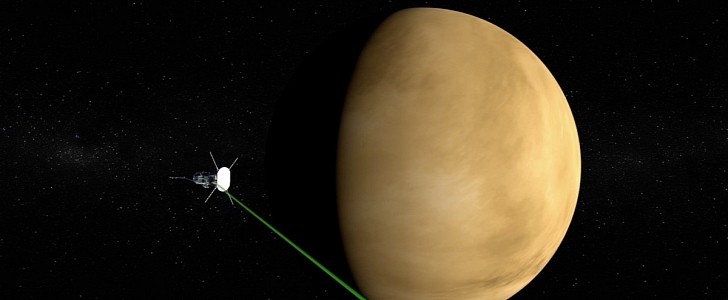This year in January, NASA's Parker Solar Probe marked its successful seventh swing across the Sun. Closer to our days, on April 29th, the spacecraft broke its own record when it flew faster and closer than ever before. The fun part? It used Venus as a slingshot, completing the fourth-of-seven Venus gravity assists. During its brief swing, it didn't miss the chance to analyze the planet's ionosphere as it detected a natural radio signal coming from the planet.
Parker's latest flyby observations show that the ionosphere of the planet is much thinner than previous measurements taken during solar maximum. It was the first direct measurement of Venus's atmosphere in 30 years. Collecting data on this and other ionosphere shifts is critical to understanding how Venus' atmosphere has changed over time.
As for the radio signal detected, Venus' upper atmosphere features a sea of electrically charged gas that naturally emits radio waves. These signals were captured by FIELDS, one of Parker’s instruments designed for measuring the electric and magnetic fields. You can actually hear how the atmosphere sounds in the video (below this text) provided by NASA as the data from probe’s FIELDS instrument was translated into sound.
Last week, the probe came within 6.5 million miles (10.4 million kilometers) from the Sun's surface while moving faster than 330,000 mph (532,000 kph). Later this year, Parker will set a new record when it uses another Venus flyby to slingshot closer to the Sun. It will approach the star's burning atmosphere to gather data on solar activity, breaking at the same time its own speed and distance records.
The spacecraft's goals include tracing the flow of energy that heats the corona and accelerates the solar wind, determining the structure and dynamics of the magnetic fields at the sources of the solar wind, and determine what mechanisms accelerate and transport energetic particles. In December 2019, Parker revealed new information about the behavior of the material and particles that flow out from the Sun.
The probe's four onboard instrument suites are now gathering data on the solar atmosphere and solar wind as it travels from the Sun, with science data collection continuing until May 4th. This year's closest approach, called perihelion, is expected to occur on November 21st, with another Venus gravity assist to occur on October 16th. It will see the Sun at just 5.3 million miles (8.5 million km) away. By 2025 the probe will travel as fast as 690,000 kph (430,000 mph), or 0.064 percent the speed of light.
As for the radio signal detected, Venus' upper atmosphere features a sea of electrically charged gas that naturally emits radio waves. These signals were captured by FIELDS, one of Parker’s instruments designed for measuring the electric and magnetic fields. You can actually hear how the atmosphere sounds in the video (below this text) provided by NASA as the data from probe’s FIELDS instrument was translated into sound.
Last week, the probe came within 6.5 million miles (10.4 million kilometers) from the Sun's surface while moving faster than 330,000 mph (532,000 kph). Later this year, Parker will set a new record when it uses another Venus flyby to slingshot closer to the Sun. It will approach the star's burning atmosphere to gather data on solar activity, breaking at the same time its own speed and distance records.
The spacecraft's goals include tracing the flow of energy that heats the corona and accelerates the solar wind, determining the structure and dynamics of the magnetic fields at the sources of the solar wind, and determine what mechanisms accelerate and transport energetic particles. In December 2019, Parker revealed new information about the behavior of the material and particles that flow out from the Sun.
The probe's four onboard instrument suites are now gathering data on the solar atmosphere and solar wind as it travels from the Sun, with science data collection continuing until May 4th. This year's closest approach, called perihelion, is expected to occur on November 21st, with another Venus gravity assist to occur on October 16th. It will see the Sun at just 5.3 million miles (8.5 million km) away. By 2025 the probe will travel as fast as 690,000 kph (430,000 mph), or 0.064 percent the speed of light.


